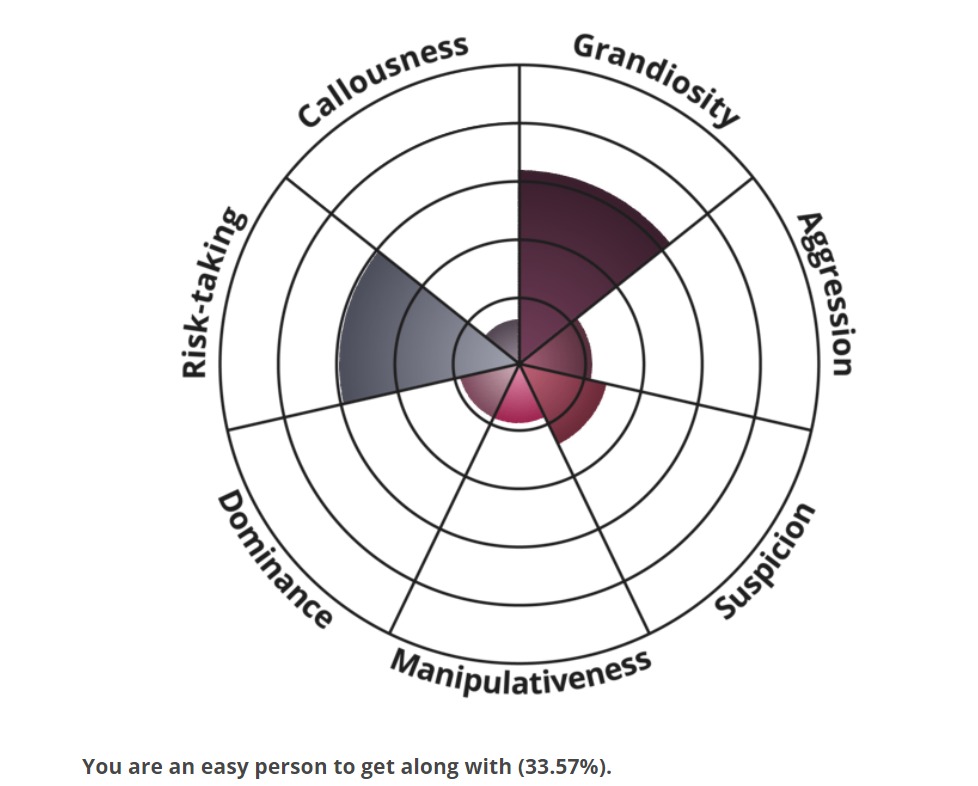Whether it is in our personal lives or professional lives, we get along with different types of people. Therefore, how we communicate and relate with others determines the bonding between us and the other persons. In many situations, some people tend to establish their viewpoints, thoughts, feelings, and of course dominance over others and forget to consider others’ emotions and viewpoints. This can result in toxic relationships.
These people are considered difficult people to along with. For instance, you may find a person in your office who gets angry very often and the co-workers tend to fear and avoid the person. You may receive dominance, anger, and toxic behaviors from your partner. You should also accurately assess yourself to learn whether your behaviors are toxic, and you are difficult to along with. The difficult person test helps you understand how difficult you are to deal with and provides graphical results across seven traits.
IDRlabs Difficult Person Test:
Chelsea Sleep and her colleagues conducted a research study at the University of Georgia and proposed the seven elements that are responsible to constitute a difficult person. They believe that it is possible to quantify the seven elements scientifically through the IDRlabs difficult person test and determine whether a person is difficult to get along with. The seven elements or traits that they use to determine a person’s ability to get along with others are Grandiosity, Callousness, Domineering, Suspiciousness, Manipulation, Aggression, and Risk-Taking.
According to Joshua D. Miller, Ph.D., a psychology professor and personality researcher at the University of Georgia, the traits should be labeled as disagreeableness rather than difficult. Being the supervisor of the research study by Sleep, he stated that the test result reflects a spectrum that ranges from antagonism to agreeableness. So, let’s focus on the seven traits of the IDRlabs difficult person test.
The Seven Traits of the Difficult Person Test:
Grandiosity:
Grandiosity refers to the grandiose sense of superiority or self-importance. Having this trait indicates that a person considers himself or herself better than others and a unique person who deserves special treatment. If you have high grandiosity, you will often tend to flaunt your abilities and accomplishments and downplay others’ contributions. Therefore, instead of focusing on healthy and accurate self-esteem, a person with a grandiose sense will display his or her superiority and a sense of entitlement about him or her.
Callousness:
Callousness refers to a lack of concern or empathy for others. A person with high callousness will be insensitive and cruel to others. High callousness also indicates a discrepancy in social sentiment. People also consider that a person with high callousness is uncivil. In simple words, a callous person will make others feel uncomfortable to get along with. According to Miller, people will feel annoyed to be callous constantly while the callousness hurts the receiver psychologically.
Aggressiveness:
Aggressiveness indicates a person’s tendency to behave crudely and disrespectfully and show resentment towards others. Aggressive people often do not remain peacefully with others, instead, they show forceful, hostile, or violent behaviors. Aggressiveness can be very hurtful if this is united with callousness, and this will make the aggressive person both unfeeling and threatening in his or her behavior. Miller’s viewpoint on this is that he could argue and show disagreeableness in his academic field, however, it might create a problem if he behaves in a similar way at his home.
Suspicion:
Suspicion can be defined as the tendency of a person to port an unreasonable and strong distrust of the people around him or her. A suspicious person often suspects others without evidence and questions the motives of even the loyal people around him or her. Suspicious tendencies may result in conspiracies and harm to others. Suspicious people often do not like to open up to others.
Dominance:
Dominance represents the desire to have superiority, influence, and power over others. Domineering individuals often underestimate others and prefer to see them as leaders. Whenever things do not go their way, they tend to react with combativeness. They can cause frustration in others as they try to control others’ decisions. A dominant person often lacks emotional intelligence and therefore, bends quickly towards extreme antagonism.
Manipulativeness:
Manipulativeness refers to one’s tendency to influence or manipulate others’ decisions, behaviors, and emotions for fulfilling his or her own purposes. A manipulative person often exploits or uses others for his or her own goals, wishes, and other benefits. Such persons do not value the rights of others and interpersonal mutuality. As these people only know how to extract from others and provide a little favor in return, therefore, they will cause frustration in others.
Risk-Taking:
The risk-taking trait represents one’s desire to take part in risky behavior in order to experience adventures and thrills. People with high risk-taking ability often end to engage in risky stunts or adventures to get rid of the boredom. You may like to engage in risky activities, but you must understand that your impulsive actions can cause bitter consequences for others. However, according to Miller, the list of treats should exclude risk-taking, and he stated that the actual research paper did not primarily include risk-taking. Later they included this trait in the test as other papers encompass this trait.
How to Take the Difficult Person Test at IDRlabs?
If you like to assess yourself and know whether you are a difficult person to build a friendly relationship with, then you must take the Difficult Person Test.
- To do this test, first of all, you have to visit the website of IDRlabs.
- On the website, you have to search for the Difficult Person Test.
- In this test, you will have to answer 35 questions by providing “agree” or “disagree” opinions on the statement. However, there are two intervals on each agree and disagree scale. If you strongly agree or disagree with a statement, you have to place the pointer on the extreme right or on the extreme left simultaneously. You can also take a neutral position.
- Once you have answered all the questions, click on the “Finish” button. Then the site will show you the result in a spectrum of the above-stated seven traits. From the spectrum, you will be able to understand your score on different traits. The site will also provide a percentage score under the spectrum. This score determines whether you are an easy or difficult person to get on with.
- Beneath the score, you will also have a beautiful and simple explanation of the meaning of the traits.
My Difficult Person Test Result and Analysis:

When I first come to know about the Difficult Person Test, I thought it would be very interesting to take the test and assess myself. Immediately, I took the test, and my score was 33.57%. The test clearly shows that I am an easy person to deal with. Then I felt the curiosity to know the results of my friends and so, I referred it to a couple of friends of mine. They got more or less similar scores. However, the interesting thing is that our spectrums looked different as we all had different levels of the seven traits. For instance, I was high in grandiosity and risk-taking, whereas one of my friends was high in aggression and manipulativeness. The other one was high in suspicion and grandiosity and a little high in risk-taking.
So, how is it possible to have different traits and even score the same? This is because each trait has a certain impact on others. For instance, you may not be a dominant or manipulative person, but if you are an extremely risk-taking person or possess a sense of superiority, that can also bring negative consequences for others. Therefore, different traits of different persons can create difficulty for others. However, the overall percentage represents whether you are a difficult person or not to get on with.
The Authenticity of the Test:
Even though the development of IDRlabs’ difficult person test occurred on the basis of the peer-reviewed research, the researchers were not there during the development process. In the research study, Sleep and her team investigated the pathological personality traits and tested the structure of antagonism on 532 participants from a southeastern university. They found antagonism as a trait that has diffident levels of intensity and specificity in different participants.
The difficult person test does not rigidly describe a person, instead, the test provides a helpful guide to fixing your negative traits. Therefore, you should not judge a person or yourself on the basis of the result. In particular, this test is a great way to look at the areas that we may not be aware of.
What should I do if I am a Difficult Person?
A difficult person is not necessarily a bad person in every aspect. There can be different reasons behind a person being different Therefore, you have to find out the reasons behind your difficult behaviors and try to restrain yourself from those behaviors. According to Miller, eventually, you should try to display warmth behavior and sympathy for others even if you do feel that way. If you try to show sympathy for others, one day, you will feel empathy for others. Miller also states that if you want to develop a healthy personality, you should be very flexible depending on the circumstances.
Remember, your difficult behaviors come repeatedly in a cyclic order. Therefore, you should break the cycle by behaving nicely. Here are some important tips for you to control your difficult behaviors-
- Try to manage your anger,
- Respect others’ opinions and give them a space to express their feelings. Do not show dominance over others.
- Display empathy towards others.
Above all, you can also consult a mental health therapist who will guide you to learn essential skills to avoid difficult behaviors.










